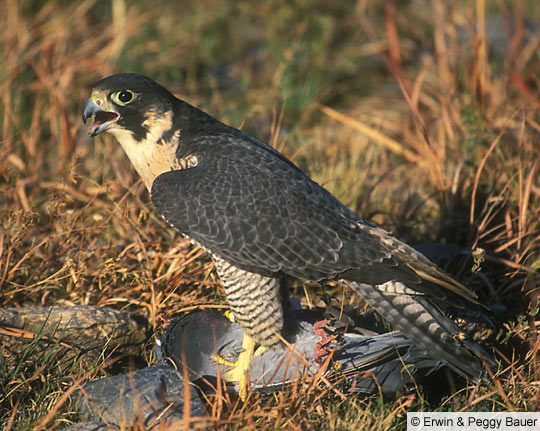

Hampton Technologies' Logo
Our logo is an Ethan David Hampton drawing of a peregrine falcon. At Hampton Technologies peregrines are iconic: we strive to achieve their level of perfection. Perhaps a little about them will make our esteem more rational.
Peregrine Falcons are widely distributed in North America -- from Mexico through the United States into Canada and Alaska -- especially in mountainous, cliff bounded river valleys or coastal zones. The photograph is representative of the subspecies (falco peregrinus anatum) that was firmly established for thousands of years before Aldo Leopold wrote "A Sand County Almanac" (circa 1948).
North America has two additional subspecies: f.p. tundrius found from Greenland across Northern Canada well into Alaska, and f.p. pealei (Peales Falcon) found near the Pacific Coast from Northern Washington through Southern Alaska and West into the Aleutian Island chain -- perhaps to Siberia.
To peregrinate is to journey widely; they do that. Falco peregrinus is distributed worldwide -- with 19 regional subspecies on every ice-free land mass except (strangely) New Zealand. Subspecies Distribution Map
The peregrine is an elegant example of evolutional success. Their fitness puts them at the top of the raptor game. Peregrines are Earth's fastest creature (without a machine); many investigators report diving speeds exceeding 300 km/hr. Their hunting skill allows them to survive anyplace they find game. Yet, they are unlikely to choose thick forest. They prefer open country where they can chase their quarry unobstructed. They eat birds and ground animals are of little interest. Even when they find birds on the ground or in the water they try to get them to fly before attacking. Peregrine Falcons are so fast and skillful that only humankind can seriously threaten them. And we did.
By 1950, our chemicals were silently killing Peregrines. Chlorinated hydrocarbons, commonly used for insect control, were ingested by prey species. While this did not kill the prey outright, it collected in their flesh -- which was eaten and further concentrated in the bodies of the Peregrines. They too, were not simply killed. No, the extinction mechanism was more insidious; these synthetic compounds block a calcium channel important to egg shell production. The embryos died when the thin shells cracked. Even if they remained intact, they were often too thin to provide an adequate water or microbe barrier. Not enough young Peregrines survived to replace their parents. World wide, several populations were lost to DDT (the map shows where they became extinct).
Without falconers it would have been worse. At the low point, they had some of the only Peregrines in North America that were not sick -- but, they were not wild and many of them did not even know how to breed. A meer handful of falconers and scientists solved this problem. They quickly developed a successful captive breeding and reintroduction program. Their plan avoided disaster.
Bringing these magnificent creatures back from the brink has taken more than thirty years. Professor Tom Cade of Cornell University teamed up with Jim Weaver, Jack Oar and several others in the first days. With their own time, money and birds, they started. In 1970 Dr. Cade founded the Peregrine Fund and hundreds of volunteers joined the effort. Like Aldo Leopold, they saw a vision more durable than themselves. Our grandchildren thank them.
The North American Peregrine Falcon was removed from the endangered species list on August 25, 1999. This was one of history's most successful conservation projects. In 1984, the Peregrine Fund consolidated their Cornell and Colorado facilities in Boise Idaho where they now focus on many remaining threats.
Dr. Frances
Hamerstrom was an Aldo Leopold graduate student at the University
of Wisconsin.
Before her death (1998) Dr. Hamerstrom was a distinguished ornithologist
and writer. Arguably however, her most important achievement was the
retraining of hundreds of young people: giving them a grander vision of
our world and their connection to it. The vision would have been dimmer
without her. Many of the people in the Peregrine rescue were her
"gabboons". Thank you Fran.
";
while(!feof ($taginfo))
{
$line = fgets($taginfo);
echo $line;
}
fclose($taginfo);
echo "
";
echo "Last modified: ";
echo $today;
echo "
"; ?>